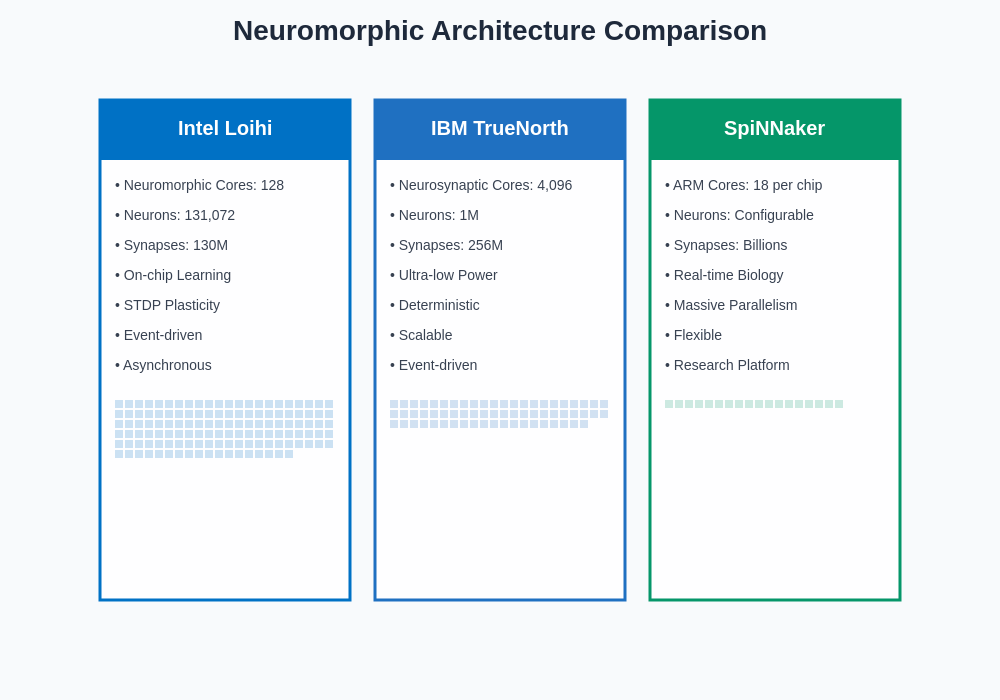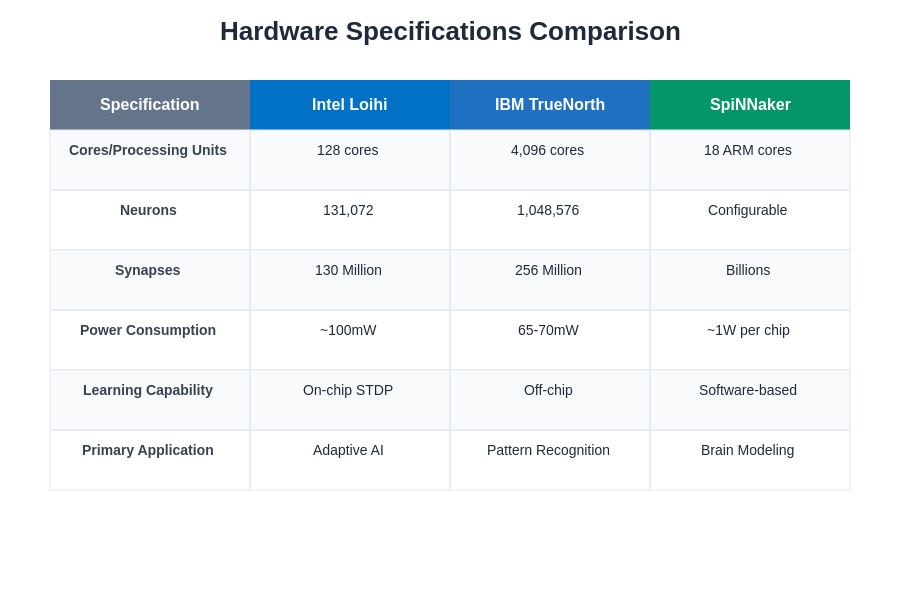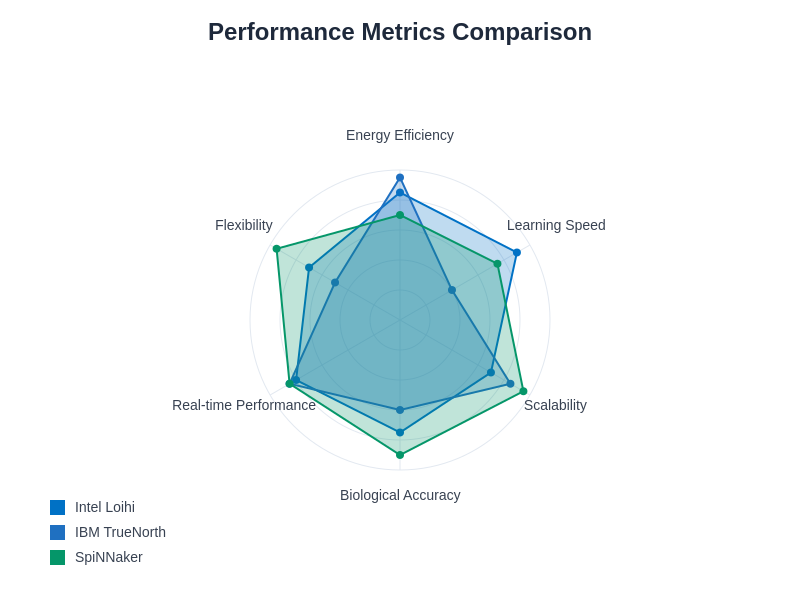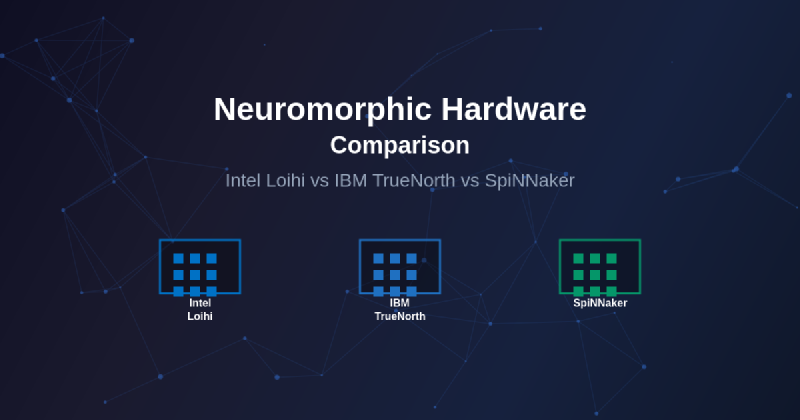The field of neuromorphic computing represents one of the most revolutionary approaches to artificial intelligence and computational efficiency, drawing inspiration directly from the human brain’s remarkable ability to process information with extraordinary energy efficiency and adaptability. At the forefront of this technological revolution stand three pioneering neuromorphic hardware platforms that have fundamentally redefined our understanding of brain-inspired computing: Intel’s Loihi, IBM’s TrueNorth, and the University of Manchester’s SpiNNaker system. Each of these groundbreaking platforms offers unique approaches to emulating neural computation, presenting distinct advantages and specialized capabilities that cater to different aspects of neuromorphic research and application development.
Explore the latest developments in AI hardware to understand how neuromorphic computing is shaping the future of artificial intelligence and computational efficiency. The convergence of neuroscience and computer engineering has produced these remarkable systems that challenge conventional computing paradigms and offer unprecedented opportunities for creating intelligent, adaptive, and energy-efficient computational solutions.
Understanding Neuromorphic Computing Fundamentals
Neuromorphic computing represents a paradigm shift away from the traditional von Neumann architecture that has dominated digital computing for decades. Unlike conventional processors that separate memory and processing units, neuromorphic systems integrate these functions in a manner that closely mimics the structure and operation of biological neural networks. This fundamental architectural difference enables neuromorphic processors to achieve remarkable energy efficiency, real-time processing capabilities, and adaptive learning behaviors that are particularly well-suited for artificial intelligence applications, sensory processing, and autonomous systems.
The core principle underlying neuromorphic computing lies in the emulation of neural spike-based communication, where information is encoded in discrete events or spikes rather than continuous voltage levels. This event-driven approach eliminates the need for constant power consumption associated with traditional digital circuits, as computation only occurs when spikes are present. Furthermore, the distributed nature of neuromorphic architectures enables massive parallelism and fault tolerance, characteristics that are inherent to biological neural networks and crucial for robust AI system implementation.

The three leading neuromorphic platforms each implement these fundamental principles through different architectural approaches and design philosophies. Intel’s Loihi focuses on learning and adaptability, IBM’s TrueNorth emphasizes large-scale neural simulation and energy efficiency, while SpiNNaker prioritizes real-time biological neural network modeling and massive parallelism.
Intel Loihi: Adaptive Learning and Plasticity
Intel’s Loihi neuromorphic research chip represents a significant advancement in brain-inspired computing, incorporating sophisticated learning mechanisms and synaptic plasticity directly into the hardware architecture. Launched as part of Intel’s neuromorphic research initiative, Loihi features 128 neuromorphic cores, each containing 1,024 primitive spiking neural units, resulting in a total capacity of approximately 131,000 neurons and 130 million synapses. This substantial computational capacity is complemented by on-chip learning capabilities that enable real-time adaptation and optimization without requiring external training procedures.
The architectural innovation of Loihi lies in its implementation of spike-timing-dependent plasticity, a biological learning mechanism that adjusts synaptic strengths based on the precise timing of neural spikes. This capability enables the chip to learn and adapt continuously during operation, making it particularly suitable for applications requiring online learning, pattern recognition, and adaptive behavior. The integration of learning algorithms directly into the hardware eliminates the need for separate training phases and enables autonomous adaptation to changing environmental conditions.
Experience advanced AI capabilities with Claude for understanding complex neuromorphic computing concepts and their applications in modern AI research. The sophisticated design of Loihi extends beyond basic neural emulation to include programmable synaptic learning rules, configurable neuron models, and flexible connectivity patterns that can be tailored to specific application requirements.
Loihi’s asynchronous, event-driven operation ensures that power consumption scales directly with neural activity, achieving remarkable energy efficiency compared to conventional processors. The chip’s hierarchical routing architecture enables efficient spike communication between cores while maintaining the sparse, distributed nature of neural computation. Additionally, Loihi includes embedded x86 processing cores that handle non-neural computations and interface with external systems, creating a hybrid architecture that combines the benefits of neuromorphic and conventional computing paradigms.
IBM TrueNorth: Scalable Neural Simulation Platform
IBM’s TrueNorth represents a groundbreaking achievement in large-scale neuromorphic computing, designed specifically to demonstrate the feasibility of brain-inspired architectures for cognitive computing applications. The TrueNorth chip incorporates 4,096 neurosynaptic cores, with each core containing 256 neurons and 256×256 synapses, resulting in a total capacity of over one million neurons and 256 million synapses. This massive neural capacity is achieved through an innovative architecture that prioritizes scalability, energy efficiency, and deterministic real-time operation.
The architectural philosophy behind TrueNorth emphasizes the separation of computation, communication, and memory functions into distinct but interconnected components that mirror the organization of biological neural networks. Each neurosynaptic core operates independently and asynchronously, communicating through spike events that are routed through a hierarchical network-on-chip infrastructure. This distributed architecture enables TrueNorth to achieve exceptional fault tolerance and scalability, as individual core failures do not compromise overall system functionality.
TrueNorth’s design prioritizes energy efficiency through several innovative approaches, including event-driven computation that only consumes power when processing spikes, aggressive power gating that shuts down inactive circuits, and optimized circuit design that minimizes leakage current. These energy-saving techniques enable TrueNorth to achieve cognitive computing performance while consuming only 65-70 milliwatts of power, representing a significant advancement in energy-efficient artificial intelligence processing.
The programming model for TrueNorth utilizes a specialized ecosystem of development tools and software frameworks that abstract the complexity of neural network mapping and optimization. The TrueNorth programming environment includes neural network compilers, simulation tools, and application development frameworks that enable researchers and developers to implement complex cognitive algorithms without requiring detailed knowledge of the underlying hardware architecture.
SpiNNaker: Biological Neural Network Emulation
The SpiNNaker (Spiking Neural Network Architecture) system, developed at the University of Manchester, represents the most ambitious attempt to create a general-purpose platform for simulating large-scale biological neural networks in real-time. Unlike Intel Loihi and IBM TrueNorth, which focus on specific neuromorphic computing applications, SpiNNaker is designed as a research infrastructure capable of modeling diverse neural phenomena and supporting neuroscience research at unprecedented scales.
The SpiNNaker architecture is built around custom ARM968 processors that are specifically optimized for neural simulation tasks. Each SpiNNaker chip contains 18 ARM cores along with shared memory and specialized communication infrastructure, while larger SpiNNaker systems can scale to millions of cores distributed across thousands of boards. This massive parallelism enables SpiNNaker to simulate neural networks containing hundreds of millions of neurons and trillions of synapses in real-time, approaching the scale of mammalian brain regions.
Discover comprehensive AI research capabilities with Perplexity to explore the vast landscape of neuromorphic computing research and applications. The flexibility of SpiNNaker’s architecture allows researchers to implement diverse neural models, from simple integrate-and-fire neurons to complex compartmental models that capture detailed biological dynamics.
The communication system in SpiNNaker is specifically designed to handle the irregular, sparse nature of neural spike patterns while maintaining real-time performance guarantees. The packet-switched communication infrastructure routes spike events between cores using a combination of hardware-accelerated routing tables and software-based packet processing, enabling efficient communication even in large-scale configurations with complex connectivity patterns.
SpiNNaker’s software ecosystem includes comprehensive simulation frameworks, model libraries, and analysis tools that support neuroscience research applications ranging from cortical modeling to sensory processing and motor control studies. The system’s ability to interface with external devices and real-time systems makes it particularly valuable for closed-loop experiments and robotic applications that require real-time neural processing capabilities.

The technical specifications and capabilities of these three neuromorphic platforms reflect their different design priorities and target applications. Intel Loihi emphasizes learning and adaptability, IBM TrueNorth focuses on energy efficiency and scalability, while SpiNNaker prioritizes biological accuracy and research flexibility.
Architectural Approaches and Design Philosophy
The fundamental architectural differences between Intel Loihi, IBM TrueNorth, and SpiNNaker reflect distinct approaches to neuromorphic computing and different prioritization of key performance characteristics. Intel Loihi adopts a learning-centric approach that integrates synaptic plasticity mechanisms directly into the hardware, enabling continuous adaptation and online learning capabilities that are essential for autonomous systems and adaptive AI applications. This design philosophy emphasizes the importance of learning and memory consolidation in creating intelligent systems that can adapt to changing environments and improve performance through experience.
IBM TrueNorth’s architectural approach prioritizes scalability and energy efficiency, implementing a highly regular, distributed architecture that can be efficiently manufactured and scaled to large system configurations. The uniform structure of TrueNorth’s neurosynaptic cores enables predictable performance scaling and simplified system design, while the event-driven operation ensures energy consumption scales with computational activity. This approach is particularly well-suited for deployment in resource-constrained environments where energy efficiency is paramount.
SpiNNaker’s architectural philosophy emphasizes biological accuracy and research flexibility, utilizing general-purpose processors that can implement diverse neural models and simulation algorithms. This approach sacrifices some energy efficiency and specialized optimization in favor of flexibility and programmability, making SpiNNaker particularly valuable for neuroscience research applications where the ability to explore diverse neural phenomena is more important than achieving maximum energy efficiency or computational throughput.
Performance Characteristics and Capabilities
The performance characteristics of neuromorphic platforms are fundamentally different from conventional processors, requiring evaluation metrics that capture the unique advantages of brain-inspired computing. Traditional metrics such as clock speed and floating-point operations per second are less relevant for neuromorphic systems, which are better evaluated based on energy efficiency per neural operation, real-time processing capabilities, learning performance, and scalability characteristics.
Intel Loihi demonstrates exceptional learning performance, with on-chip plasticity mechanisms enabling rapid adaptation to new patterns and environmental changes. The chip’s ability to perform online learning while maintaining low power consumption makes it particularly suitable for edge AI applications where continuous adaptation is required. Loihi’s energy efficiency scales favorably with network sparsity, achieving significant power savings when processing sparse neural activity patterns that are common in real-world applications.
IBM TrueNorth excels in energy efficiency metrics, achieving cognitive computing performance at power consumption levels that are orders of magnitude lower than conventional processors. The chip’s deterministic operation and regular architecture enable predictable performance scaling and simplified system integration, making it attractive for applications requiring guaranteed real-time performance and energy constraints. TrueNorth’s fault tolerance capabilities also provide advantages in mission-critical applications where system reliability is paramount.
SpiNNaker’s performance characteristics are optimized for large-scale neural simulation, with the ability to simulate millions of neurons in real-time while maintaining biological time constants and dynamics. The system’s scalability enables researchers to explore neural phenomena at scales approaching those of mammalian brain regions, providing unprecedented opportunities for understanding complex neural behaviors and emergent properties of large neural networks.

The comparative analysis of performance metrics reveals the specialized strengths and trade-offs inherent in each neuromorphic platform. Energy efficiency, learning capabilities, simulation scale, and biological accuracy represent key dimensions along which these systems can be evaluated and compared.
Application Domains and Use Cases
The distinct architectural characteristics and capabilities of Intel Loihi, IBM TrueNorth, and SpiNNaker make them suitable for different application domains and use cases within the broader neuromorphic computing ecosystem. Understanding these application-specific advantages is crucial for selecting the appropriate platform for particular research or commercial applications.
Intel Loihi’s learning capabilities and adaptive behavior make it particularly well-suited for autonomous systems, robotics, and edge AI applications where continuous adaptation and online learning are essential. The chip’s ability to learn from sparse, irregular sensory inputs makes it valuable for applications such as gesture recognition, anomaly detection, and adaptive control systems. Loihi’s integration with conventional computing systems also enables hybrid applications that leverage both neuromorphic and digital processing capabilities.
IBM TrueNorth’s energy efficiency and scalability characteristics make it attractive for mobile and embedded applications where power consumption is a critical constraint. The chip’s ability to process sensory data with minimal energy consumption makes it suitable for always-on applications such as keyword spotting, visual surveillance, and environmental monitoring. TrueNorth’s deterministic operation also makes it valuable for safety-critical applications where predictable performance is required.
SpiNNaker’s biological accuracy and research flexibility make it the platform of choice for computational neuroscience research, brain modeling studies, and neuromorphic algorithm development. The system’s ability to simulate diverse neural phenomena enables researchers to explore fundamental questions about neural computation, learning mechanisms, and emergent behaviors in large neural networks. SpiNNaker’s real-time capabilities also enable closed-loop experiments and brain-machine interface applications.
Development Ecosystems and Programming Models
The software development ecosystems surrounding Intel Loihi, IBM TrueNorth, and SpiNNaker reflect their different target audiences and application domains, with each platform providing specialized tools and frameworks optimized for their respective strengths and capabilities.
Intel’s Loihi development ecosystem, branded as Intel’s Neuromorphic Research Community, provides comprehensive software tools including the Nengo framework integration, custom neural compiler tools, and simulation environments that enable researchers to develop and deploy neuromorphic applications. The ecosystem emphasizes ease of use and integration with existing AI development workflows, providing high-level abstractions that hide hardware complexity while enabling access to advanced neuromorphic features when needed.
IBM’s TrueNorth ecosystem includes the TrueNorth programming environment, neural network mapping tools, and optimization frameworks that enable efficient deployment of cognitive algorithms on the TrueNorth architecture. The development tools prioritize performance optimization and resource utilization, providing detailed analytics and profiling capabilities that enable developers to maximize the efficiency of their neuromorphic applications.
SpiNNaker’s software ecosystem is built around the SpiNNaker software stack, which includes PyNN compatibility for standard neural network description, custom simulation kernels, and extensive model libraries covering diverse neural phenomena. The ecosystem emphasizes flexibility and research capability, providing researchers with the tools needed to implement novel neural models and explore cutting-edge neuroscience questions.
Energy Efficiency and Sustainability Considerations
Energy efficiency represents one of the most compelling advantages of neuromorphic computing platforms, with all three systems demonstrating significant improvements over conventional processors for neural computation tasks. The biological inspiration underlying neuromorphic architectures naturally leads to energy-efficient designs that mirror the remarkably low power consumption of biological neural networks.
Intel Loihi achieves energy efficiency through event-driven operation, aggressive power gating, and optimized circuit design that minimizes static power consumption. The chip’s learning capabilities also contribute to energy efficiency by enabling adaptation that can optimize neural network configurations for specific tasks and environments, potentially reducing the computational resources required for achieving desired performance levels.
IBM TrueNorth represents a landmark achievement in energy-efficient cognitive computing, with the chip consuming only 65-70 milliwatts while performing complex pattern recognition and classification tasks. This energy efficiency is achieved through a combination of architectural innovations including asynchronous operation, sparse connectivity patterns, and optimized circuit design that eliminates unnecessary power consumption.
SpiNNaker’s energy efficiency is achieved through the use of power-optimized ARM processors and intelligent power management that scales energy consumption with computational activity. While SpiNNaker may not achieve the same energy efficiency levels as specialized neuromorphic chips like Loihi and TrueNorth, its flexibility and programmability provide opportunities for implementing energy-efficient algorithms and exploring power optimization techniques.
The sustainability implications of neuromorphic computing extend beyond individual chip efficiency to include reduced cooling requirements, lower infrastructure costs, and decreased environmental impact of large-scale AI deployments. The energy efficiency advantages of neuromorphic platforms become increasingly significant as AI applications scale to larger deployments and more widespread adoption.
Integration Challenges and System Considerations
The integration of neuromorphic platforms into existing computing systems and application environments presents unique challenges that require careful consideration of interface requirements, software compatibility, and system architecture design. Unlike conventional processors that operate within well-established computing paradigms, neuromorphic platforms require specialized approaches to system integration and application development.
Intel Loihi addresses integration challenges through its hybrid architecture that includes conventional x86 cores alongside neuromorphic processing units, enabling seamless integration with existing software stacks and development tools. This approach simplifies the deployment of neuromorphic applications while providing access to the full capabilities of both neuromorphic and conventional computing paradigms.
IBM TrueNorth’s integration approach focuses on providing high-level software abstractions and development tools that hide the complexity of the underlying neuromorphic architecture while enabling efficient deployment of cognitive algorithms. The platform includes specialized compilers and optimization tools that automatically map neural networks to the TrueNorth architecture, reducing the burden on application developers.
SpiNNaker’s integration challenges are addressed through comprehensive software frameworks and interface standards that enable connection to external systems and real-time data sources. The platform’s flexibility enables custom integration solutions tailored to specific research requirements, although this flexibility may require more specialized expertise and development effort compared to more structured platforms.
Future Developments and Research Directions
The future evolution of neuromorphic computing platforms will likely focus on addressing current limitations while expanding capabilities and application domains. Key research directions include improved learning algorithms, enhanced energy efficiency, larger-scale integration, and better development tools and programming models.
Intel’s future neuromorphic research directions include the development of more sophisticated learning algorithms, improved energy efficiency through advanced circuit techniques, and enhanced integration with conventional computing systems. The company’s investment in neuromorphic research suggests continued development of more capable and versatile neuromorphic platforms that can address broader application domains.
IBM’s neuromorphic research continues to focus on scaling and energy efficiency improvements, with potential future developments including larger-capacity chips, enhanced learning capabilities, and improved programming tools and frameworks. The company’s broader cognitive computing strategy suggests continued investment in neuromorphic technologies as enablers of more efficient and capable AI systems.
SpiNNaker’s future developments are likely to focus on increased scale, improved energy efficiency, and enhanced biological accuracy. The ongoing SpiNNaker 2 project aims to address current limitations while maintaining the platform’s flexibility and research capabilities, potentially enabling simulation of even larger neural networks with improved biological fidelity.
The convergence of neuromorphic computing with other emerging technologies such as quantum computing, photonic computing, and advanced materials science may lead to hybrid approaches that combine the advantages of different computing paradigms. These interdisciplinary developments could unlock new capabilities and application domains that are not achievable with any single technology alone.
Industry Impact and Commercial Adoption
The commercial adoption of neuromorphic computing platforms is gradually accelerating as the technology matures and demonstrates clear advantages for specific application domains. Early adoption is primarily focused on research institutions, technology companies, and specialized application areas where the unique capabilities of neuromorphic platforms provide significant competitive advantages.
Intel’s commercialization strategy for neuromorphic computing includes partnerships with research institutions, technology companies, and government agencies to explore applications and develop use cases that can drive broader adoption. The company’s established position in the semiconductor industry provides advantages for scaling manufacturing and supporting commercial deployments of neuromorphic platforms.
IBM’s approach to neuromorphic commercialization focuses on cognitive computing applications and enterprise solutions that can benefit from the energy efficiency and real-time processing capabilities of neuromorphic platforms. The company’s broader AI and cognitive computing portfolio provides context and integration opportunities for neuromorphic technologies.
The commercial impact of neuromorphic computing extends beyond individual chip sales to include the broader ecosystem of software tools, development frameworks, and application solutions that enable the deployment of neuromorphic technologies. The development of this ecosystem is crucial for broader adoption and commercial success of neuromorphic platforms.
The competitive landscape of neuromorphic computing is expanding with new entrants and increased investment from established semiconductor companies, suggesting growing recognition of the technology’s potential and commercial viability. This increased competition is likely to accelerate innovation and improve the capabilities and cost-effectiveness of neuromorphic platforms.
Conclusion and Future Outlook
The comparison of Intel Loihi, IBM TrueNorth, and SpiNNaker reveals the diverse approaches and capabilities within the neuromorphic computing landscape, each offering unique advantages and addressing different aspects of brain-inspired computation. Intel Loihi’s emphasis on learning and adaptability makes it particularly suitable for autonomous systems and adaptive AI applications, while IBM TrueNorth’s focus on energy efficiency and scalability addresses the needs of mobile and embedded applications with strict power constraints. SpiNNaker’s biological accuracy and research flexibility provide unprecedented capabilities for computational neuroscience research and large-scale neural modeling.
The future of neuromorphic computing will likely see continued evolution and specialization of these platforms, with each developing enhanced capabilities while maintaining their core strengths and target application domains. The integration of neuromorphic technologies with conventional computing systems will enable hybrid approaches that leverage the advantages of both paradigms, creating more capable and efficient computing solutions for AI and cognitive applications.
The growing interest in neuromorphic computing from industry, academia, and government agencies suggests that these technologies will play an increasingly important role in the future of artificial intelligence and computational efficiency. As the field continues to mature, we can expect to see broader adoption, improved development tools, and new application domains that fully leverage the unique capabilities of brain-inspired computing architectures.
Disclaimer
This article is for informational and educational purposes only and does not constitute professional or technical advice. The information presented is based on publicly available specifications and research publications. Readers should conduct their own research and consult with appropriate experts when considering neuromorphic computing platforms for specific applications. The capabilities and specifications of neuromorphic platforms may change as the technology continues to evolve, and actual performance may vary depending on specific use cases and implementation details.
